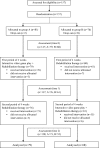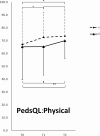The Impact of Short-Term Video Games on Performance among Children with Developmental Delays: A Randomized Controlled Trial
- PMID: 26983099
- PMCID: PMC4794225
- DOI: 10.1371/journal.pone.0149714
The Impact of Short-Term Video Games on Performance among Children with Developmental Delays: A Randomized Controlled Trial
Abstract
This prospective, randomized controlled study investigated the effects of short-term interactive video game playing among children with developmental delays participating in traditional rehabilitation treatment at a rehabilitation clinic. One hundred and one boys and 46 girls with a mean age of 5.8 years (range: 3 to 12 years) were enrolled in this study. All patients were confirmed to suffer from developmental delays, and were participating in traditional rehabilitation treatment. Children participated in two periods of 4 weeks each, group A being offered intervention of eight 30-minute sessions of interactive video games in the first period, and group B in the second, in addition to the traditional rehabilitation treatment. The physical, psychosocial, and total health of the children was periodically assessed using the parent-reported Pediatric Quality of Life Inventory-Generic Core Scales (PedsQL); and the children's upper extremity and physical function, transfer and basic mobility, sports and physical functioning, and global functioning were assessed using the Pediatric Outcomes Data Collection Instrument. Parental impact was evaluated using the PedsQL-Family Impact Module for family function, PedsQL-Health Satisfaction questionnaire for parents' satisfaction with their children's care and World Health Organization-Quality of Life-Brief Version for quality of life. Compared with the baseline, significant improvements of physical function were observed in both groups (5.6 ± 19.5, p = 0.013; 4.7 ± 13.8, p = 0.009) during the intervention periods. No significant improvement of psychosocial health, functional performance, or family impact was observed in children with developmental delays. Short-term interactive video game play in conjunction with traditional rehabilitation treatment improved the physical health of children with developmental delays.
Trial registration: ClinicalTrials.gov NCT02184715.
Conflict of interest statement
Figures



References
-
- Tseng WC, Hsieh RL. Effects of short-term active video game play on community adults: under International Classification of Functioning, Disability and Health consideration. Chin Med J (Engl). 2013;126(12):2313–9. . - PubMed
-
- Dworak M, Schierl T, Bruns T, Strüder HK. Impact of singular excessive computer game and television exposure on sleep patterns and memory performance of school-aged children. Pediatrics. 2007;120(5):978–85. . - PubMed
Publication types
MeSH terms
Associated data
LinkOut - more resources
Full Text Sources
Other Literature Sources
Medical

